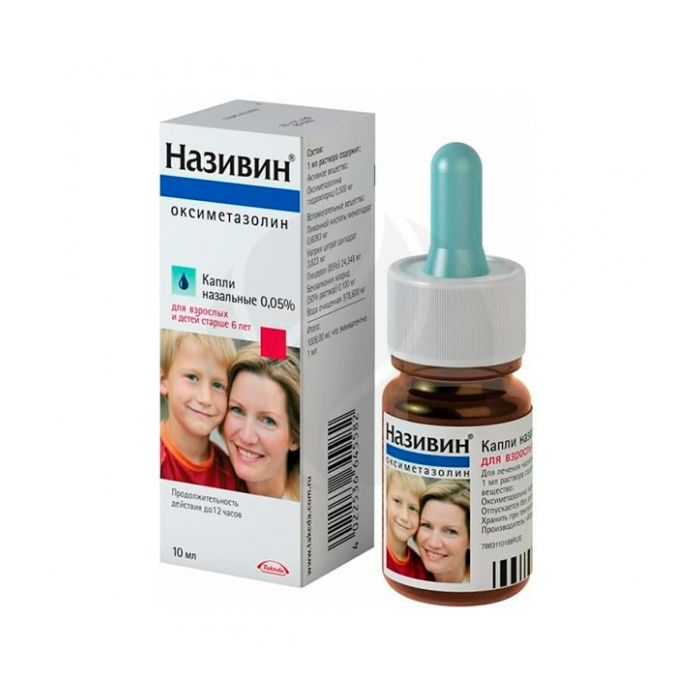Nazivin from 6 years old drops 0.05%, 10ml
Expiration Date: 05/2027
Russian Pharmacy name:
Називин с 6 лет капли 0,05%, 10мл
Treatment of acute respiratory diseases accompanied by rhinitis;
allergic rhinitis;
vasomotor rhinitis;
restoration of drainage in case of inflammation of the paranasal sinuses, eustachitis, otitis media;
elimination of edema before diagnostic manipulations in the nasal passages.
Drops NazivinЃ are intended for instillation into the nose.
Adults and children over 6 years old should be prescribed drops of 0.05%, 1-2 drops in each nostril 2-3 times / day.
Children aged 1 to 6 years should be prescribed drops of 0.025%, 1-2 drops in each nostril 2-3 times / day.
Children under the age of 1 year are prescribed drops of 0.01%.
Newborns (children under 4 weeks of age) are injected 1 drop into each nostril 2-3 times / day.
Children aged 1 month to 1 year are prescribed 1-2 drops in each nostril 2-3 times / day.
To ensure dosing accuracy, the 0.01% drop bottle has a graduated pipette with markings for the number of drops. If 1 drop is prescribed, then the pipette should be filled with solution up to the 1 mark.
The effectiveness of the following procedure has also been proven: depending on age, 1-2 drops of a 0.01% solution are applied to cotton wool and wipe the nasal passages.
NazivinЃ should be used within 3-5 days. Doses in excess of the recommended dosages are prescribed at the discretion of the physician.
Active substance:
Oxymetazoline hydrochloride
Excipients: citric acid monohydrate, sodium citrate dihydrate, glycerol, benzalkonium chloride, purified water
Atrophic rhinitis;
angle-closure glaucoma;
children under 6 years of age (drops and nasal spray 0.05%)
hypersensitivity to the components of the drug.
You should adhere to the recommended concentrations of the drug intended for different age categories (see methods of application).
Caution should be given with the simultaneous use of MAO inhibitors and other drugs that increase blood pressure, as well as in the period up to 10 days after the discontinuation of these drugs; with increased intraocular pressure; during pregnancy and lactation; with severe forms of cardiovascular diseases (arterial hypertension, angina pectoris); with thyrotoxicosis and diabetes mellitus.
pharmachologic effect
Vasoconstrictor drug for local use, alpha2-adrenergic agonist.
When applied topically to inflamed nasal mucous membranes, it reduces swelling and discharge. Restores nasal breathing. Eliminating the edema of the mucous membranes, the drug helps to restore aeration of the paranasal sinuses, the middle ear cavity and prevents the development of bacterial complications (sinusitis, sinusitis, otitis media).
With local intranasal application in therapeutic concentrations, oxymetazoline does not have a systemic effect, does not irritate the mucous membranes and does not cause hyperemia.
The drug starts to work within a few minutes.
Duration of action up to 12 hours.
Side effect
Local reactions: sometimes - dryness and a burning sensation of the nasal mucosa, sneezing, in rare cases (after the end of Nazivin's action) - a feeling of nasal congestion (reactive hyperemia).
From the side of the central nervous system: rarely - anxiety, insomnia, fatigue, headache.
From the digestive system: rarely - nausea.
From the side of the cardiovascular system: with repeated overdose, arterial hypertension, tachycardia are possible.
Long-term continuous use of vasoconstrictor drugs can lead to tachyphylaxis, atrophy, and recurrent edema of the mucous membranes of the nasal cavity (rhinitis medicamentosa).
Application during pregnancy and lactation
The use of the drug during pregnancy and lactation is possible only after a careful assessment of the ratio of benefits to the mother and the risk to the fetus or infant. Exceeding the recommended dose is unacceptable.
Application in children
Contraindicated in children under 6 years of age (drops and nasal spray 0.05%).
Children over 6 years old should be prescribed drops of 0.05%, 1-2 drops in each nostril 2-3 times / day.
Children aged 1 to 6 years should be prescribed drops of 0.025%, 1-2 drops in each nostril 2-3 times / day.
Children under the age of 1 year are prescribed drops of 0.01%: newborns (children under 4 weeks of age) are injected 1 drop into each nostril 2-3 times / day; children aged 1 month to 1 year are prescribed 1-2 drops in each nostril 2-3 times / day.
Long-term use and drug overdose should be avoided.
special instructions
Long-term use and overdose of the drug should be avoided, especially in children.
Influence on the ability to drive vehicles and control mechanisms.
After prolonged use of drugs containing oxymetazoline in doses exceeding the recommended ones, a general effect on the cardiovascular system and the central nervous system cannot be ruled out; in these cases, the ability to drive a vehicle or equipment may be impaired.
Overdose
Symptoms: with a significant overdose or ingestion, pupillary constriction, nausea, vomiting, cyanosis, fever, tachycardia, arrhythmia, collapse, cardiac depression, arterial hypertension, pulmonary edema, respiratory distress may occur. In addition, mental disorders can be observed, as well as inhibition of the central nervous system, accompanied by drowsiness, a decrease in body temperature, bradycardia, arterial hypotension, respiratory arrest and the possible development of coma.
Treatment: gastric lavage, intake of activated charcoal.
Drug interactions
With the simultaneous use of Nazivin with MAO blockers or tricyclic antidepressants, an increase in blood pressure is observed.
The co-administration of other vasoconstrictor drugs increases the risk of side effects.

